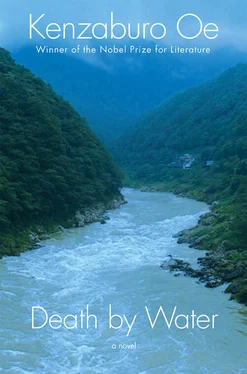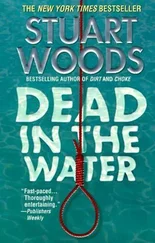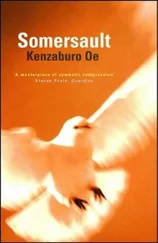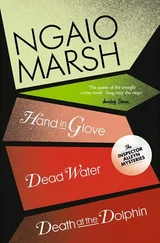There were times when I felt it might have been better to tackle that project sooner rather than later, but I always managed to suppress those urges by telling myself the moment still wasn’t right. I needed to pay my dues by struggling, and suffering, and striving to overcome all the character-building difficulties I would encounter while writing the other books I was meant to produce first, for practice. If I could escape so easily into writing the drowning novel, then what would be the point of the struggle?
3
Nevertheless, I did make a stab at writing the drowning novel, just once, when I was in my midthirties. I had already published The Silent Cry, which seemed to prove that I had attained a certain degree of proficiency, and that accomplishment gave me the confidence to dive in at last.
I dashed off a rough prologue and sent it along with a number of related notes to my sixtysomething mother, who was still living in the forests of Shikoku where I grew up. I enclosed a letter saying that in order to continue working on this book, which would focus on my father, I would like to take a look at his papers and whatever else was stored in the red leather trunk (an exotic piece of luggage that had been in our family since before I was born). However, I didn’t receive a direct reply from my mother, even though she had been saying all along that the raw materials for the novel in question were in the trunk. Nor did she ever return the rough draft of the prologue or any of the other notes I had sent.
Unable to proceed, I had no choice but to abandon the project. However, in the summer of the following year, fueled by unabated anger at my mother, I published The Day He Himself Shall Wipe My Tears Away. The main characters in that novella were grotesquely exaggerated versions of myself and my father, and it also included what some critics perceived as a merciless caricature of my mother (although others lauded the character as a solitary voice of reason).
Not long after, I received a postcard from my sister, Asa, who was still living at home. “Lately Mother has been criticizing you in terms even more scathing than the deliberately spiteful and alienating words you used to describe her at the end of your nasty little book,” she wrote. Asa’s message concluded by announcing that she and our mother had decided to sever all relations with Kogii (my childhood nickname), effective immediately. I was, she said, disowned.
4
Some years before the publication of that novella, my son, Akari, had been born with a defect in his skull, and eventually this ongoing real-life crisis helped to restore my relationship with my mother. Everyone’s shared concern about Akari — who, amazingly, survived and overcame his obstacles — seemed to serve as a kind of intermediary buffer. The lines of communication between Chikashi and the Shikoku contingent were reopened, and we all began the long, slow process of easing back into an amicable family relationship.
However, until the day she died at the age of ninety-five, my mother never said a word about the prologue and notes for my drowning novel, or about the red leather trunk. I did hear that she used to reminisce to my sister, saying things like “When Kogii was a young boy here in the village he wasn’t very well-adjusted, and because I tried to interfere, his character may have ended up being irreparably damaged,” so perhaps she was just determined not to repeat the mistakes she thought she had made in my upbringing. Not only that, but before she passed away she even went to the trouble of planning ten years into the future!
5
Setbacks notwithstanding, I never doubted that I would eventually write the drowning novel. If you were to ask whether there were times when I found myself thinking about the stalled project, I would have to acknowledge that there were. (One example that springs to mind is when I was living alone in a foreign country, while another occurred just after I had learned of the death of someone for whom I felt great respect and affection.) But I was never inspired to jot down any new ideas, much less to pick up where I’d left off.
However, after Asa informed me that it was finally time for me to take possession of the red leather trunk, I suddenly found myself unable to think about anything except resuming work on the drowning novel — an undertaking that had been in limbo for what seemed like an eternity. Even amid those feelings of excited anticipation, though, it struck me that on some level I had been gearing up all along to tackle the project again. I was certain everything I needed was in the red leather trunk Asa was about to hand over to me: the materials my mother had preserved for so many years, along with the rough prologue and assorted scribbles I had mailed to her nearly half a century earlier and hadn’t laid eyes on since. As for the literary skills I would need in order to complete this challenging book, surely I had acquired the necessary tools during my decades of actively practicing the craft. But that encouraging thought was overlaid with a poignant sense that my life as a novelist might soon be approaching its end.
6
At long last I was ready to plunge headfirst into the drowning novel, and in order to do that I needed to pick up the red leather trunk. Then something happened — something very odd and unexpected — that made the idea of a trip to Shikoku seem considerably more appealing.
My house in Tokyo sits on a hill at the far end of the Musashino Plain. If you descend the western slope of the incline, you will see that a large area, originally nothing more than swampland, has been extensively developed around a canal-like waterway. A cycling path was built for the use of the residents of the towering apartment blocks that have gone up one after another, but it is also open to the public.
One day while I was walking on the path with my disabled son, I happened to run into an entirely unexpected individual …. That line was part of the opening scene of a novel I wrote soon after turning seventy. If I were to write again now that I made a new friend while strolling along the same cycling path, people would probably say with pitying smiles, “Oh, look, the poor old thing is plagiarizing himself — again!” But the simple truth is that for an elderly person like me who lives a somewhat reclusive life, there simply aren’t very many locations where chance encounters with the outside world can take place.
It was a morning in early summer. I set out alone for a walk, leaving Akari at home. In recent years my son’s physical decline had advanced to the point where any kind of sustained exertion had become an ordeal for him, and he required increasingly large doses of medicine to keep his epileptic seizures under control.
As I was ambling along I heard the sound of light footsteps behind me, beating out an even rhythm on the pavement, and a moment later someone overtook me and swiftly passed on by. I saw then that it was a diminutive young woman; her long black hair had been lightened to a deep brown hue, and she wore it pulled back in a single ponytail. She was dressed in a beige shirt and matching chinos, and there wasn’t a single wrinkle in the soft, thin, lustrous fabric of her slacks. They fit her like a glove, and the contours of her lower body were plainly visible. Her thighs appeared to be shapely and sturdy without being excessively muscular, and above them the sinewy curves of her small buttocks undulated lithely as she walked. While I was still observing her retreating figure, the girl quickly left me in the dust and vanished from sight.
As I continued at my usual leisurely pace, I spotted the girl up ahead doing stretches or calisthenics in a small landscaped area equipped with benches, iron bars, and other fitness equipment. She would gently extend one leg in front of her, lower her hips, and hold that stance for several seconds. Then she would change legs and repeat. When the girl had overtaken me earlier I’d caught a glimpse of an attractively round face, but seen now in profile as I passed the little plaza she looked more like a lovely, ivory-skinned demoness — in Japanese mythological terms, a hannya. (I once read a theory that Japanese beauties can be divided into two categories: moonfaced, plump-cheeked Otafuku types, named after the bawdy goddess of the underworld, and foxy-looking, angular-featured female demons.)
Читать дальше










